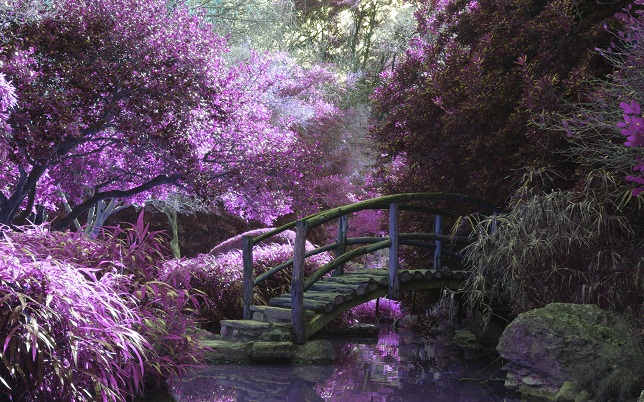India was abounded in fruit trees like mangoes, jack fruit, tamarind etc from the ancient times. But the Muslim rulers of India, besides setting up new cities and settlements and providing means of irrigation, imported fruit and flower plants from far off lands and laid out large formal gardens.
To name only a few a large number of fruit plants such as dates, apple, coconut, lemon, orange, grapes were imported by the Muslim rulers of India. These rulers coming from Iran and Central Asia took special delight in the romantic beauty of delicately laid out gardens and built such a large number of retreats of this kind that hardly any part of the country was deprived of these pleasances.
The fact is that an innumerable number of gardens planted by the Muslim rulers of India. No historian can claim to enumerate all the gardens laid out during the Muslim period of India. We have accordingly, tried to mention only the important gardens of the Muslim era.
Contents
Huge Garden Works by Muslim Ruler Alauddin Khilji
As mentioned by the historians the first Muslim monarch who planted extensive gardens was Alauddin Muhammad Khilji. He laid out thirty gardens In Delhi, eighty in Salora and forty four in Chittor and imported seven varieties of white and black grape vines from abroad.
Massive Garden Works by Muslim Ruler Zain-ul-Abidin
Sultan Zain-ul-Abdin of Kashmir had a garden of 518 hectares laid out at Zinagar near Trehgam where fruit trees and flowers brought from distant places were planted amidst enchantingly flowing water courses.
The Sultan laid out many other gardens which made Kashmir a paradise on earth. One of the big gardens laid out by Sultan Zain-ul-Abdln was at Zinapur.
Colossal Garden Work by Muslim Ruler Mahmud Shah
Sultan Mahmud Shah had a large number of gardens planted in Gujarat. He was so enthusiastic about it that he gave cash rewards to all those who laid out formal gardens or even planted a single fruit-tree. The patronage of Mahmud Shah soon made the widows and invalids to plant fruit trees or lay out gardens on their back-yards and spare lands.
A large number of fruit-trees were imported from abroad and the whole of Gujarat was soon virtually turned into a lovely garden. Different varieties of fruits, unknown to the region earlier, became available in great plenty.
One of the many pleasure gardens laid out by Mahmud Shah was named by him as Firdaus. It covered an area of 8 Km. in length and about 1.5 Km. in breadth and had a hundred thousand fruit trees.
Efforts of Bahmani Rulers
Alauddin bin Ahmad Shah Bahmani had a large garden, known as Niamatabad, laid out at Bedar which also contained magnificent palaces (Firishta, Vol. III, p. 150). A number of poets including Azraqi composed eulogies praising this garden.
Imaduddin Mahmud Gilani, a minister of the Bahmini kings, laid out a delightful garden in Ahmadabad in which saffron of good quality was grown besides several other imported varieties of fruits and flowers (Firishta). Mahmud Gilani also had a sumptuous garden laid out at Bijapur.
Gardens at Ahmadnagar by Muslim Rulers
Mahmud Shah Khilji planted a large garden containing numerous varieties of fruit trees at Zafarabad in 1441. A similar enclosure was planted by Ahmad bin Hasan al-Baheri Nizam Shah in Tikapur, by the name of Nizam-ul- Hadiqa, to commemorate his victory over the Bahminis. In 1489, Ahmad constructed palatial buildings in the garden which gradually developed into the city of Ahmadnagar.
Murtaza Nizam Shah I charged Niamat Khan Samnani to construct a garden by name Farah Bakhsh(meaning pleasure giving) at Ahmadnagar, but as it did not meet the expectations of the king, another minister Salabat Khan raised another lovely garden in 1583. A number of poets composed eulogies extolling verdure and beauty of this garden. Salabat Khan laid out a few more gardens in Ahmadnagar and also encouraged others to do the same. It is reported that one of his gardens had five lakh fruit trees.
Gardens by Ibrahim Adil Shah
Ibrahim Adil Shah, King of Bijapur, ordered Shahwar Khan to plant a garden at Bijapur in 1601. It was such a fine garden with enclosing ramparts tanks and palatial buildings, that Muhammad Qasim, the famous historian and another litterateur, Shilli, who had seen the garden have paid glowing tributes to it.
Huge Garden by Quli Qutb Shah
Muhammad Quli Qutb Shah laid out a spacious garden, 6.5 Km. long and 3 Km. wide near Hyderabad. The author of Hadiqatul Alam states that besides fruit trees of numerous varieties the garden had also a big herbarium.
Massive Garden works by Muslim Ruler Babar
Babar had four gardens laid out at Agra in which he got planted a number of fruit-bearing trees and flower plants imported from Kabul. Babar also took keen interest in laying out canals and pleasure retreats. Babar was the first king to lay out gardens in accordance with a pre-determined plan of rectangles and straight lines with arcaded pavilions, water cascades, fountains, low terraces and many-sided water courses. One of the four gardens laid out by Babar at Agra was known as Gulfishan. In it were grown different varieties of fruits, such as grape vines of Sahibi, Habshi, Kishmishi species.
Pineapple plants were brought to be planted in the garden from far-off places and the flogged causeways were shaded by such imported trees as cypress, cedar, poplar willow, sandal etc.
The huge incentives provided by the Moghuls to gardening and horticulture soon paid dividends, as mentioned in Tuzuk-e-Babri and Ain-e- Akbari, in the shape of abundance of fruits like water melon, coconut, banana, pistachio-nuts, apples, etc.
Colossal Garden Works in Kashmir by Muslim Rulers
Nawab Quli Khan, the Governor of Kashmir during the reign of Akbar from 1589 to 1601, laid out a number of gardens and took steps to renovate the gardens planted by the earlier kings of Kashmir which had fallen into ruins. He introduced peach in the Kashmir valley by obtaining its plants from Kabul. He also invented the grafting of trees which, according to the contemporary historians, improved the quality of fruits and also increased their yield.
Lake Tiryak in Kashmir from which rises the river Bhat, better known as Jhelum, flows to Srinagar and then to Punjab, was enclosed by high embankments and surrounded by a series of palatial buildings and terraced gardens by Emperor Jahangir.
Another garden was laid out by one of Jahangir’s grandees, Nawab Muqrrab Khan, at Kairana in which he had planted a large number of fruit and flower plants imported from abroad. It is reported that the Nawab had grown almost all the varieties of mangoes in his garden which had also 300 cypress trees. Jahangir who had visited this garden, made a mention of it in his Memoirs.
Incredible Shalimar Garden by Shahjahan
The world-famed Shalimar garden of Kashmir was laid out in 1618 by Shahjahan during the reign of Jahangir by the side of the clear waters of Dal lake. A canal about 460 metres long was taken out of the Dal to connect it with another pool. The terraced pathway along the canal was shaded by rows of magnificent chunar trees and graced by green swards. This pathway led to a summer palace beyond which was another pool of crystal waters with a paved floor all round it and fountains playing within the pool at a distance of every 15 paces.
On the farther side of the pool was built another imposing pavilion, on either side of which were two smaller streams with fountains dancing within them, and bounded by the rows of chunars. Both the edifices in the Shalimar garden were crowned by domes over the central vault around which were spacious halls having four doors. Two of these doors opened on the two sides of the canal while the remaining two led to the bridges over the canal.
This lovely pleasure garden with the stately pavilions of exquisitely carved stones, excellently proportioned in structure, and in complete harmony with the charming background of the mountains had no rival throughout the great Moghul empire.
More Garden Works during Shahjahan’s Reign
Later on Shahjahan constructed a very large pleasure retreat at Lahore in 1642, at a cost of 6 hundred thousand rupees, on the pattern of Kashmir’s Shalimar garden which was laid out on a threefold terrace.
On the upper terrace there is a pillared marble kiosk with a reservoir in the centre. Down this the water ripples into pond below from where it falls into another reservoir and passes to the extremity of the garden which has splendid cupolas with numerous fountains dancing the watercourses.
Shahjahan laid out gardens in Agra, Ahmadabad and Delhi besides many other places. The one at Delhi had a big pool of crystal waters from which flowed a canal six cubits in width with 112 fountains out of which 49 were made of silver. Delhi’s Shalimar Garden was situated at a distance of about
10 miles from the Lahori Gate, outside the city (Athar-us-Sanadid, pp. 287-88). Like other Moghul gardens, arcaded pavilions of marble and red sandstone occupied the central position in its numerous parts surrounded by shaded causeways and intricate lace-work of waterways and fountains playing amidst plots of flower-beds and delicious fruit trees.
Another garden named Akbarabadi Mahal was laid out in 1649 on the pattern of Shalimar garden at a distance of 4 km. from the Red Fort at Delhi by one of the wives of Shahjahan. The expenditure incurred on the construction of pavilions, canals and channels, as mentioned in Badshahnamah was two hundred thousand rupees.
Nawab Jahan Ara, a daughter of Shahjahan also constructed canals and pools in 1649 along with palatial buildings within a garden laid out by her at Delhi. The garden was located near Chandni Chauk (Athar-us-Sanadid, p. 284). Sir Syed has made a mention of numerous other gardens laid out in Delhi during the reign of Shahjahan.
Gardens by other Muslim Rulers
Nawab Lashkar Khan was another governor of Kashmir during the reign of Shahjahan. He beautified the northern bank of Dal lake and constructed an imposing pavilion overlooking the lake.
Nawab Zafar Khan of Tirthut who was the governor of Kashmir under Shahjahan laid out four gardens in the valley of Kashmir, one in Muzaffarabad, the other known as Bagh-i- Gulshan in Bunakudal, the third one, Bagh-i-lnayat, near the mausoleum of Sheikh Ali bin Shahab Hamadani and the fourth at Husnabad. Numerous flower and fruit plants not grown earlier in Kashmir were raised in these gardens.
Son of Bayram Khan, Khan-i-Khanan Mirza Abdur Rahim had a number of gardens laid out in Gujarat during the tenure of his governorship of the province. Khan-i-Khanan successfully raised for the first time the crop of yellow musk-melon of Kabul in one of his gardens which later on became common in India. Jahangir who inspected Khan-i- Khanan’s Fateh Bagh at Ahmadabad, expressed his appreciation of the fine pleasure retreat..
Nawab Ali Mardan Khan, a governor of Kashmir, got several gardens laid out in Kashmir. Two of his well-known gardens with stately palaces were situated in pargana Mur and Naushehra. The former was known as Aliabad garden.
Saif Khan, the governor of Kashmir during Aurangzeb’s time planted a garden by the name of Bagh Saifabad in the Kashmir valley and another at Sirhind. Both of these gardens contained dignified edifices.
The above were examples of only a very few of the major gardens and fruit cultivation efforts by Muslim rulers of India and the fact is that no other rulers of India even come close to Muslim rulers in their efforts to beautify and enrich India and its people.

